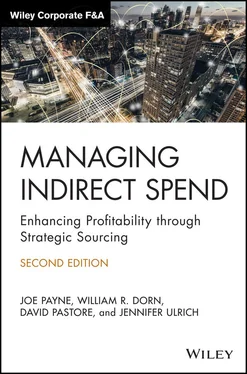Many large organizations—from publicly traded services companies without procurement departments, to large industrial manufacturers that allow each plant to purchase independently without leveraging volumes, or healthcare providers that have relied on their group purchasing organization to effectively manage budgets for them—still do not know how to achieve substantial cost savings on all of the “stuff” they buy. The people burdened with these tasks often do not know where to begin. It is for these beleaguered souls that this book has been written.
In our experience, resources for these types of organizations are sorely lacking. Many consulting firms and analysts pitch sourcing optimization and a variety of other buzzwords with which they seek to replace the term “Strategic Sourcing.” For some reason, people have begun to associate the Strategic Sourcing process with the standard three‐bid‐and‐buy process that most organizations have been using for decades. They all believe they are sourcing strategically; therefore, management does not see the need to provide the proper people, technology, time, and training to effectively manage spend and look for cost reduction opportunities. Industry analysts and other experts are already looking to identify the next big thing—calling strategic sourcing irrelevant, outdated, or ineffective—while their customers continue to struggle with getting their arms around the basics of what it means to source strategically.
WHAT THIS BOOK WILL DO FOR YOU
Whether you are an executive, procurement professional, or any individual concerned with reducing spend and strengthening your supply chain, this book will provide you with the knowledge and necessary tools to successfully reduce costs in the area of indirect spend. The processes and real‐world examples in this book are based on more than 20 years of consulting experience and the successful implementation of cost reduction strategies for clients of all sizes, in just about every industry and in hundreds of spend categories.
Specifically, this book provides you with the following:
An overview of the challenges faced when sourcing indirect spend categories
An overview of the Strategic Sourcing process
A description of the tools and technology that can help you source and manage the procurement process more efficiently and effectively.
A do‐it‐yourself guide to building and maintaining a best‐in‐class procurement organization
This book focuses on specifics instead of theory and will detail how to actually get started, run through the process, and implement cost savings across a wide variety of indirect spend categories. It also details the most important aspects of strategic sourcing that many other books overlook: the use of creativity when performing research; how to identify leverage points during negotiations; and most importantly, effectively dealing with people, both externally and within your own organization.
Recently, the procurement and supply chain management profession as a whole has received more focus than ever before. In fact, procurement and supply chain professionals are now regularly covered in mainstream media publications and are even quoted on cable news channels. Because of this sudden awareness of our profession, no shortage of consulting firms have been jumping on the bandwagon and offering strategic sourcing services. Many of these firms employ the same standard tactics that organizations have been using for years, while trying to rebrand their services to sound more impressive.
The primary authors of this book were utilizing a Strategic Sourcing process and best‐in‐class procurement techniques long before they were well known. Our team consists of experienced supply chain and procurement leaders who have led and managed thousands of strategic sourcing initiatives for mid‐market and Fortune 500 customers and have helped stand up or digitize hundreds of procurement organizations. We are successful in producing savings in more than 97% of all of the initiatives we have tackled. Over the course of our work, we have seen what companies do right and, more importantly, what companies do wrong and in many cases fail to do at all.
HOW THIS BOOK IS ORGANIZED
The book is broken into four parts: Process, Tools, Examples from the Field, and How to Do It.
Part Oneof this book provides you with a detailed, step‐by‐step account of the typical Strategic Sourcing process, outlining the steps with which most sourcing professionals are already familiar. These steps include Data Collection and Spend Analysis, Research, the RFx process, Negotiations, Contracting, Implementation, and Continuous Improvement. Each step of the process is covered as a separate chapter in this section, providing an explanation of the goal of that step in the process, a high‐level overview of the tools needed to reach the goal, and the people involved. Each chapter also provides an in‐depth account of how to work with people, both inside and outside your organization, to achieve optimal results.
Part Oneconcludes with a chapter on “What Not to Do,” specifically focusing on our years of hands‐on experience seeing the mistakes other procurement professionals have made in the past (and continue to make) and offering lessons to help you avoid similar pitfalls. Some topics of discussion include sending spam RFPs, creating overly complicated sourcing documents, allowing a supplier to write RFPs for you, and not engaging the right stakeholders within an organization.
Part Twoof this book provides an overview and analysis of the resources and technologies that can help professionals source and purchase more effectively. The first chapter in this section defines market intelligence and its importance as a primary tool in the Strategic Sourcing process. It also defines the distinction between static and dynamic intelligence and offers guidelines for using each. It continues by describing types of static and dynamic market intelligence, such as industry publications and commodity reports, group purchasing organizations, online tools, and consultants.
The second chapter in this section focuses on the technologies and software solutions that are available in the marketplace. It explains the advantages and disadvantages of using software tools and sheds light on some of the best‐kept secrets of procurement tools as well as little‐known free technologies that are available online
The last chapter in this section discusses using stakeholder engagement as a tool to motivate suppliers and implement change within the organization, outlining how critical it is to your organization to have a team of committed stakeholders to ensure the success of your sourcing project.
Part Three: Examples from the Field
Part Threeprovides a detailed account of some first‐hand experiences we have had helping customers reduce costs by employing the Strategic Sourcing process, including some of the most creative solutions we have developed as well as some of the most challenging sourcing engagements we have come across. Each chapter in Part Threeoffers you an example of each experience and covers different sourcing strategies.
The first chapter defines some of the creative methods you can use to get your incumbent supplier, or potential supply base, to assist you in strengthening a relationship and reaching your own organization's goals. We discuss tactics that can be used to help get your suppliers on board with your goals and help them help you drive savings.
The second chapter discusses tactics that help you become the ideal customer in the eyes of your supplier. Typically, gaining this status leads to improved supplier relationships and even larger savings opportunities. We then conclude with specific examples in which clients have leveraged supplier feedback to gain improvements in their supply chain.
Читать дальше












